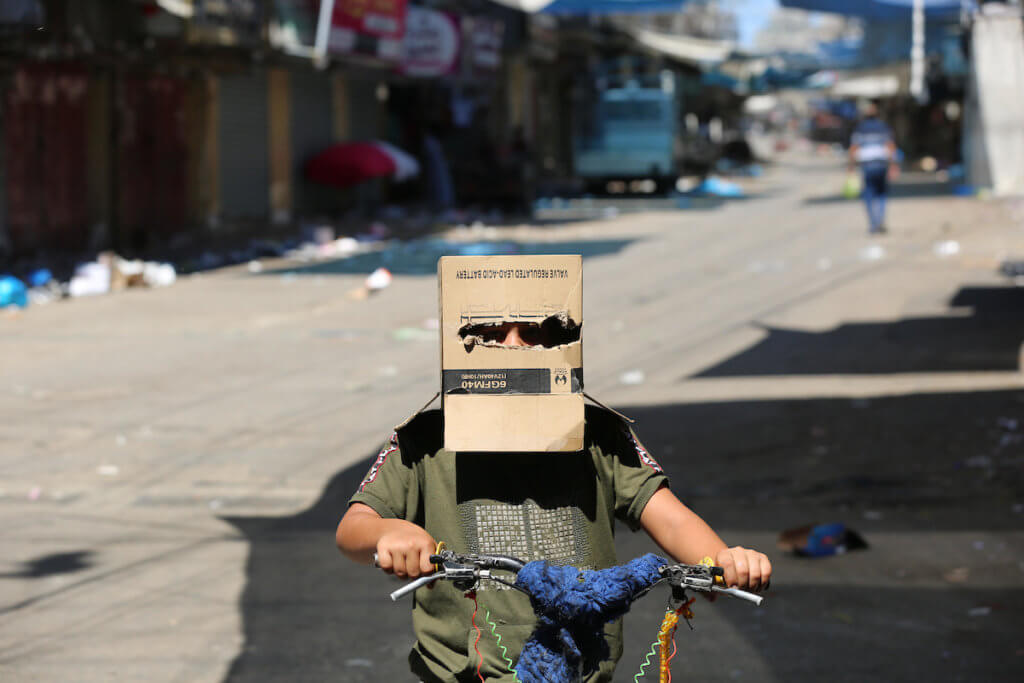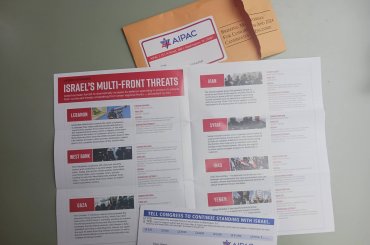A Palestinian child wears a mask made from a cardboard box as a precaution against the spread of the coronavirus during a lockdown imposed following the discovery of the first coronavirus cases in the Gaza Strip, in Khan Younis in the southern Gaza Strip August 25, 2020. (Photo: Ashraf Amra/APA Images)
The Latest:
- 28,110 confirmed COVID-19 cases among Palestinians; 21,059 in the West Bank; 192 in Gaza; 6,859 in East Jerusalem
- 160 Palestinians deaths
- Cases in Israel increased by more than 8,000 this week, totaling 111,493; 891 Israeli deaths
- 2,000 new confirmed COVID-19 cases in Israel on Thursday
Gaza at the precipice
Officials in Gaza saw early on that their healthcare system couldn’t handle more than a few dozen critical patients if the coronavirus spread. A decision was made in March to use the siege, which has kept so much out, as a shield to ward off the virus. Already hemmed in by walls, fences, a buffer zone and checkpoints, the borders were shut with the exception of Palestinians returning from abroad who were promptly forced into quarantine centers. Some were put up in resort style hotels and to much criticism, others were sleeping ten to a room in schools with flimsy cots.
The gambit seemed to have worked for nearly five months, however, on Monday this all changed when health officials learned of the first cases of community transmission. The coronavirus in now officially running loose in Gaza and the scope is unknown.
In the last few days, six tested positive for COVID-19 outside of isolation centers. Two were in a hospital (but not a COVID-19 treating hospital), and four were from a single family in the al-Maghazi refugee camp.
Swiftly, Hamas closed businesses and ordered a broad scale lockdown on Monday for 48 hours, extending it through the weekend on Wednesday.
These new patients raise the question — how equipped is Gaza to respond to cases outside of tightly monitored isolation centers?
Under an Egyptian and Israeli blockade for 13 years, Gaza’s hospitals are understaffed, medications stocks are at around 50%, and medical equipment is at 30%. For the last five months nearly all of the tests in Gaza went to those inside government isolation centers as part of the tightly controlled borders strategy, and until recently it was nearly impossible for anybody but a returning traveler or healthcare worker to get a COVID-19 test. There are no drive-through clinics in Gaza, no CVS rapid response locations, or firehouses making testing available.
We know that so far at least 18,273 have been tested in Gaza, but we also know the total number of tests that were delivered to Gaza and the difference is a mere 500. The numbers were published in this week’s situation report from the World Health Organization who also procured the test and have spearheaded technical expertise on the ground.
There are only 86 oxygen ventilators in the entire coastal enclave fit to serve a population of more than 2 million. Around 50 devices were in-use before anyone had heard of SARS-CoV-2, meaning there is a maximum of 36 vents available for new COVID-19 patients. This number includes the 10 the World Health Organization brought in this week, the first ventilators to enter since the start of the pandemic. The UN plans to import another 20.
The WHO estimates Gaza needs an additional 50 ventilators. This is based on the estimate that 5% of all COVID-19 positive patients need intubated oxygen support.
“The population of Gaza is under terrible strain,” said Ignacio Casares Garcia, head of the ICRC’s Gaza Subdelegation. “People are stressed: not only are they coping with just four hours of electricity a day; their worries over the virus have been hugely compounded and they are now under lockdown.”
Another factor that is compromising Gaza’s labs’ ability to process more tests is that this week Gaza was plunged into an energy crisis when fuel transfers were reduced following an escalation of tensions between Hamas and Israel. When the fuel didn’t arrive, the Strip’s only power plant was forced to shut down. Now, most families have just four hours of electricity a day. The impacts are felt not just at homes where Palestinians are self-isolating in daily temperatures in the 90s. Hospitals also lost power and are now supported by emergency generators.
“The Laboratories Department at the Ministry of Health announced that the prolonged power outages would hinder COVID-19 lab testing and have already led to the damage of COVID-19 samples, which must be stored at minus 20 Celsius. He explained that the use of generators might affect the accuracy of the tests and delay results, causing an immense waste of testing kits and high-cost consumables,” The Gaza-based human rights group Al Mezan said.
‘People are afraid to open their windows,’ enduring the pandemic in a West Bank refugee camp

Like Gaza, the West Bank is grappling with a new aspect of the health crisis where officials are wrestling to control the spread in densely populated areas. Mondoweiss’s Yumna Patel investigated how families in Dheisheh refugee camp are coping with lockdown for the virus’s second wave in the first of a five part video series that will explore the social, economic, and political repercussions that the pandemic is having on the occupied Palestinian territory.
In the last week, 65 new cases were confirmed in the camp, which sits on less than half a square mile and is home to more than 15,000 Palestinian refugees. The camp was founded in 1949 and was originally designed to accommodate around 3,000.
“I can guess that in a month or two, if the situation stays like this, we will have hundreds of cases,” Hamzeh Jalham, a community organizer from Dheisheh, told Patel.
She reports: “Most refugee camps like Dheisheh are home to three, even four generations of Palestinian refugee families. With so many people living in such a small space, overcrowding has become a major issue for Palestinian refugees during COVID-19.”
Another refugee, Maysoun Abu Sadoud, told Patel about the perils of online education. Abu Sadoud is keeping her five children home from school. To access their classwork, they take turns sharing a family-owned smart phone.
“We can’t afford to buy a laptop or a computer, or any of these kinds of technologies that are really expensive, especially during this time,” Abu Sadoud said.
To catch the next installment where Patel will continue to examine daily pandemic life in Palestine, make sure to hit that subscribe button.


